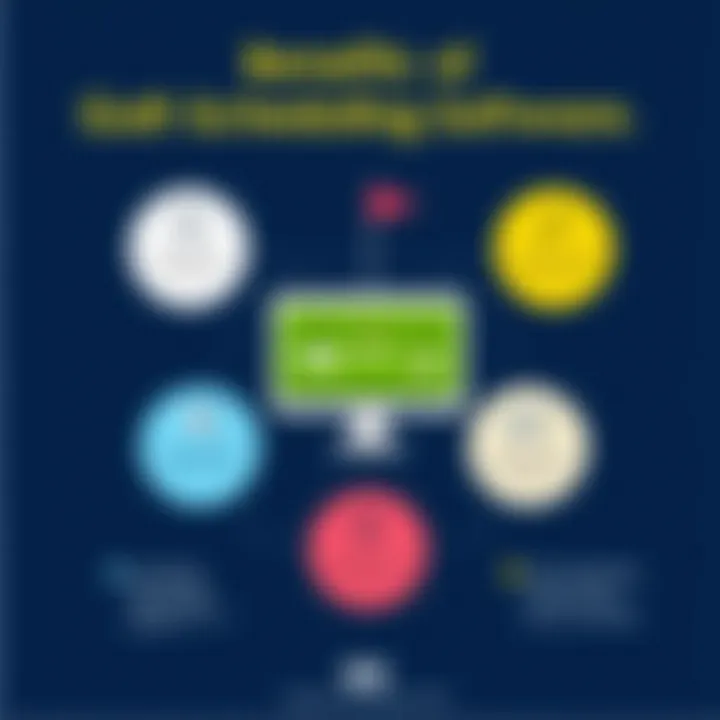Explore the Benefits of Golf Scheduling Software


Intro
In the modern landscape of golf management, conducting operations more smoothly is no small task. As golf facilities strive for higher efficiency and improved customer satisfaction, keeping up with the latest technological advances is a necessity. Golf scheduling software has emerged as a crucial asset for managing tee times, reservations, and even the intricate scheduling of events. In this article, we will break down the key components of this software, dissect its inner workings, and present a balanced view based on user experiences.
Through our deep dive, readers will not only learn what features are essential but also how these tools can fundamentally change day-to-day operations. From small public courses to high-end private clubs, understanding what's available on the market is vital for any facility looking to stay ahead of the curve.
Whether you're an IT professional pushing for retail efficiency or a decision-maker at a golf facility, grasping the nuances of scheduling software can facilitate a comprehensive understanding of how to maximize its utility for your operations.
Overview of Golf Scheduling Software
When it comes to managing a golf facility, scheduling is of utmost importance. The dynamics of a golf course rely heavily on efficient booking systems and customer management. This section sheds light on golf scheduling software, an essential tool for modern golf operations. Understanding this software can significantly enhance how golf facilities operate, integrating numerous aspects from booking tee times to managing customer data.
Definition and Purpose
Golf scheduling software refers to programs designed specifically to help golf courses manage their bookings, staff, and customer relations effectively. Simply put, it's a digital assistant, providing a backbone for day-to-day operations. Imagine running a busy golf course and having to manage scores of bookings while keeping track of customer preferences and payments—this is where scheduling software comes into play.
The purpose of such software goes beyond just taking bookings. It creates a virtual hub where user experiences, operational flows, and administrative tasks meet. This software should create a seamless booking experience, allowing players to reserve tee times through easy-to-use interfaces, whether it's on their computers or mobile devices. By enhancing communication and reducing errors associated with manual scheduling, the software allows golf managers to focus on what matters most: delivering a great golfing experience.
Importance in Golf Management
In the world of golf management, inefficient scheduling can lead to chaos. A well-implemented golf scheduling software is crucial for various reasons:
- Operational Efficiency: Automating the booking process minimizes the amount of time staff spend on the phone or at the desk managing reservations. This automation translates into a smoother operational flow.
- Enhanced Customer Experience: Players appreciate easy booking options and immediate confirmations. Providing a user-friendly interface can make or break their decision to return to a course.
- Data Insights: Quality golf scheduling software can offer valuable insights into player trends, helping course managers to make data-driven decisions.
- Resource Management: Proper scheduling helps in managing everything from the number of available carts to staff scheduling. This ensures that the course is always ready for players.
"In the age of technology, adapting to innovative solutions like golf scheduling software can set a facility apart from the rest."
Understanding golf scheduling software is not just about the nuts and bolts of tee time management; it's about leveraging technology to meet both operational goals and customer satisfaction. As we delve deeper into this subject, we'll explore the features and types of software available, enabling golf facilities to thrive in an increasingly competitive market.
Key Features of Golf Scheduling Software
In the realm of golf management, the selection of appropriate scheduling software can be a game changer. Golf scheduling software isn’t merely about booking tee times; it encapsulates a bundle of innovations aimed at streamlining operations. By focusing on key features, facilities can enhance user experiences, boost team productivity, and achieve operational goals efficiently.
Certainly, understanding these features gives golf managers the insight needed to choose software that aligns well with their specific needs and objectives.
User-Friendly Interface
A user-friendly interface is paramount when considering golf scheduling software. A well-designed graphical user interface enables both staff and patrons to navigate the system with ease. Simple layouts, clear labels, and intuitive icons promote quick accessibility, fostering a seamless experience for users.
For example, if a software package looks like a labyrinth with tiny buttons and unclear instructions, users may feel as lost as a golfer in a dense fog. Therefore, ensuring that the interface is appealing and straightforward not only attracts new customers but also retains existing users.
Real-Time Booking Capabilities
Real-time booking capabilities are crucial in a day and age when patrons expect instant results. Golfers should have the ability to check availability, book, and confirm tee times immediately via the software platform. This reduces frustration and helps in managing high demand seamlessly.
Consider a scenario: A busy Saturday morning, with a packed course. A software that allows real-time updates prevents double bookings and enhances user trust. Timely notifications about cancellations or last-minute openings can also bolster customer satisfaction.
Payment Processing Integration
Payment processing integration can’t be overlooked. Swift, secure transactions are a must in today's digital world. The software should offer various payment options, such as credit cards, PayPal, or even mobile wallets like Venmo. Additionally, integrating invoicing systems can streamline financial management.
When users can complete transactions with minimal steps, it simplifies the entire booking process. Moreover, confidence in secure payment gateways can significantly enhance users’ willingness to make advance bookings.
Customer Relationship Management Tools
The inclusion of Customer Relationship Management (CRM) tools within golf scheduling software can be advantageous for building and maintaining client relationships. By analyzing user data, facilities can tailor marketing efforts and enhance customer experiences based on preferences.
For instance, if a golfer regularly books morning tee times, sending personalized reminders or offers for breakfast specials can drive repeat business. Effective CRM tools lead to stronger engagement, turning regular players into loyal patrons.
Reporting and Analytics Functions
Robust reporting and analytics functions provide insight that goes beyond simple metrics. Understanding how the course is utilized, peak hours, customer preferences, and overall revenue trends informs strategic decisions.
Consider this: A golf course manager may find that certain times of year see higher occupancy than others. By analyzing this data, they can adjust pricing strategies or marketing efforts during off-peak seasons, helping to maximize profits. Detailed reports can also assist in identifying opportunities for improvement or tailoring service offerings based on data-driven insights.
Investing in quality golf scheduling software is like having a seasoned caddy; it helps in decision-making by providing valuable information quickly and effectively.
By focusing on these key features within golf scheduling software, managers can streamline their operations and create an enhanced experience for golfers. Having a user-friendly interface, real-time booking, secure payment capabilities, CRM tools, and analytics not only improves efficiency but also cultivates a loyal customer base. Selecting software with these capabilities ensures that golf facilities stay competitive in a growing market.
Types of Golf Scheduling Software


In the world of golf management, the choice of scheduling software can either make or break operational efficiency. Knowing the types of golf scheduling software available is crucial, as each serves unique business needs and varying levels of user engagement. The types can mainly be divided into three categories: Cloud-Based Solutions, On-Premise Software, and Mobile Applications. Understanding these divisions provides insight into the benefits, potential pitfalls, and specific use cases for each option, which assists decision-makers in making the most informed choices.
Cloud-Based Solutions
Cloud-based golf scheduling software is, without a doubt, the rising star in the tech landscape. With its remote access capabilities, golf facilities can manage bookings, members, and payments from anywhere in the world, given they have internet access. This flexibility provides a distinct edge, particularly for businesses that operate multiple locations or experience fluctuating staffing requirements.
- Advantages of Cloud-Based Solutions:
- Accessibility: Users can log in from any device, ensuring that crucial operations can continue without fuss.
- Real-Time Updates: Changes to bookings or schedules are visible instantly across all devices, mitigating the risk of double bookings.
- Cost-Effectiveness: Many cloud options operate on a subscription basis, reducing upfront costs and allowing for small monthly payments instead.
While the benefits are numerous, one must also be aware of some concerns. For example, if the internet connection falters, access to information can become problematic.
On-Premise Software
In contrast, on-premise software is designed to be installed at specific locations, often on local servers. This method can provide a reliable framework for golf clubs that prefer handling their data internally. But it’s important to assess the specific needs of the business.
- Benefits of On-Premise Software:
- Data Control: Businesses maintain total control over their data, ensuring security and compliance with local regulations.
- Customization: Many on-premise solutions allow companies to tailor the software to their unique needs, enhancing specific workflows.
- Performance: Without reliance on internet connectivity, these systems can perform robustly, assuming hardware is well-maintained.
However, stakeholders should also weigh the considerable initial investment and maintenance costs associated with on-premise solutions. Leveraging IT professionals for upkeep or issues may become necessary, further escalating expenses.
Mobile Applications
As more businesses recognize the importance of mobility, many are turning to mobile applications specifically designed for golf scheduling. These apps are often an extension of cloud-based solutions, offering on-the-go access so that users can manage bookings from their smartphones.
- Key Advantages of Mobile Applications:
- User Engagement: Golfers can check availability and book tee times from virtually anywhere, driving increased revenue for the facility.
- Push Notifications: Applications can send alerts about special offers or changes in scheduling, creating a more engaged customer base.
- Integration with Other Tools: Many apps allow for seamless integration with other management tools like CRM systems, making them extremely efficient.
Nevertheless, mobile applications do require an initial investment in app development or licensing fees, as well as a need for regular updates and maintenance. This can become an ongoing consideration for budget-conscious facilities or those with tighter operational margins.
"Choosing the correct type of golf scheduling software can make a significant difference in operational success as well as customer satisfaction."
Comparison of Leading Golf Scheduling Software
The comparison of golf scheduling software is a crucial part of understanding the landscape of tools available to golf facilities today. As the golf industry evolves, so does the need for effective management solutions that can streamline operations and enhance customer interactions. This section will delve into where various software solutions stand in terms of features, usability, and cost, aiding decision-makers in selecting the right platform that aligns with their operational goals.
Market Leaders Overview
In the realm of golf scheduling software, a few companies consistently make waves. These market leaders are recognized for their comprehensive solutions that address the multifaceted needs of golf facilities. For instance, ChronoGolf is known for its user-friendly interface designed for ease of access, while GolfNow offers powerful marketing tools alongside scheduling.
Each of these platforms has carved out a niche by focusing on what different golf courses require, from large resorts that offer extensive amenities to smaller country clubs seeking efficiency and simplicity. Listing some of their notable features helps set the stage for comparisons:
- ChronoGolf - Intuitive booking, integrated tee time management, and customer review features.
- GolfNow - Strong marketing strategies, extensive outreach capabilities, and a large user base that drives higher visibility.
- Teesnap - A focus on integrating operational aspects with financial reports, providing a comprehensive overview of a golf facility's performance.
A detailed understanding of these market leaders reveals their unique stances. Each offers distinctive advantages that may resonate differently with potential users based on their specific operational needs and customer expectations.
Feature Comparison
When assessing the strengths of leading golf scheduling software, examining key features is paramount. Various tools offer specific advantages that cater to unique needs within the golf management ecosystem. The following are essential aspects to consider:
- User Interface: A clean and intuitive user experience can streamline operations. Software that offers a straightforward layout improves the likelihood of staff and customer satisfaction.
- Booking Management: Real-time availability checks and easy booking capabilities are crucial for enhancing customer convenience.
- Customer Relationship Management: Tools that support ongoing customer relationships, like automated follow-ups or personalized offers, can significantly enhance membership retention.
- Payment Integration: Seamless integration with payment processors is vital for smooth financial transactions, making the user experience more frictionless.
For golf professionals, having an overview of these functionalities informs better choices. Thus, it’s essential to weigh which features align with the strategic goals and the expected customer experience.
Pricing Analysis
Pricing varies significantly across different platforms, greatly influenced by the features offered and the scale of operations. Typically, providers such as ChronoGolf and GolfNow have tiered pricing models which can accommodate everything from small clubs to larger resorts. This modular approach allows businesses to choose what they need instead of paying for unnecessary features, which is especially essential for smaller operations on a tighter budget.
Additionally, businesses should consider:
- Monthly vs. Annual Costs: Some software solutions offer discounts for annual subscriptions. Users must do the math to find the optimal financial commitment.
- Setup Fees: Several companies charge initial fees for installation or onboarding, so understanding these costs upfront can prevent nasty surprises.
- Transaction Fees: For platforms managing payments, being aware of any hidden charges per transaction can impact profitability.
In summary, analyzing software pricing models in conjunction with features and market positioning is critical for those operating within the golf sector. The right choice often comes down to balancing cost with the essential tools needed for effective management.
Overall, evaluating and comparing different golf scheduling software systems should not be a rushed decision. A careful review of capabilities, benefits, and aligned costs will lead to finding the optimal fit for enhancing golf operations.
Benefits of Using Golf Scheduling Software


In the fast-paced world of golf management, utilizing a robust scheduling software solution isn't just about convenience—it's about transforming how a facility operates. The benefits of using golf scheduling software span a variety of critical operational areas. These advantages can significantly enhance a golf facility's ability to function efficiently, improve customer experiences, and harness valuable data insights. Let’s explore these aspects further.
Enhanced Operational Efficiency
Golf scheduling software brings a new level of efficiency to daily operations. By automating tasks like tee time bookings, cancellations, and member management, facilities can minimize manual processes that often bog down staff. This automation reduces the likelihood of errors, which can be as headache-inducing as forgetting an appointment. Instead of spending hours juggling phone calls and trying to fit everyone in, staff can focus on providing an excellent golfing experience.
Imagine a golf course where scheduling runs seamlessly. Wouldn’t that be a dream? Well, with the right software, it can be a reality. Facilities can easily manage multiple tee times across different courses, allowing for maximum use of resources without overlaps or confusion.
Efficient scheduling can also lead to better resource management. With real-time data visibility into course conditions, bookings, and even weather forecasts, managers can make quicker decisions on operations, like allocating carts or adjusting staffing levels based on player volume. Such decisions not only save time but can also affect the bottom line positively.
"An efficient scheduling system is not just a tool; it’s the backbone of a successful golf management strategy."
Improved Customer Satisfaction
When customers are happy, they return. Golf scheduling software plays a significant role in elevating customer satisfaction. The convenience of online bookings, mobile access, and real-time updates keeps players informed and engaged. Nobody enjoys waiting on hold just to reserve a tee time. Today’s tech-savvy golfers appreciate a smooth, quick, and hassle-free reservation process.
Furthermore, personalized experiences can be enhanced. Member management features allow facilities to track player preferences and tailor services accordingly. For example, if a golfer prefers to play in the morning, the software can suggest suitable tee times automatically. This not only adds a personal touch but can lead to increased loyalty, as players feel valued.
In addition, immediate communication features allow for timely updates on weather changes or course conditions, avoiding disappointments when golfers arrive to face unexpected obstacles. With a solid scheduling tool in place, customers will feel cared for and better accommodated, fueling their love for the game.
Data Management and Insights
In this data-driven age, making informed decisions is paramount for success in any business, including golf facilities. Golf scheduling software gathers a wealth of data regarding bookings, usage patterns, and customer demographics. This information is invaluable, as it allows managers to devise strategies based on concrete trends rather than guesswork.
By analyzing this data, golf courses can identify peak playing times, understand customer preferences, and adjust marketing efforts accordingly. For instance, if data reveals an influx of bookings during weekday afternoons, a facility might consider offering special deals to attract more golfers during non-peak hours.
Moreover, advanced analytics can contribute to better financial planning. Understanding revenue generated per time slot helps in optimizing pricing strategies. Are morning slots overpriced, or is there still demand to satiate? The answers lie in the numbers. With this insightful information at their fingertips, leaders can steer their facilities with greater precision, ensuring both growth and sustainability.
Challenges in Implementing Golf Scheduling Software
Implementing golf scheduling software can seem like a straightforward task, yet it comes with its own set of challenges. Organizations that look to modernize their processes may find themselves navigating a maze of technical, financial, and human factors that must be addressed to ensure a smooth transition. Understanding these challenges is crucial for businesses in the golf industry, as it allows them to prepare adequately, mitigate risks, and maximize the advantages these tools bring.
Integration with Existing Systems
One of the most significant hurdles is ensuring that new scheduling software integrates seamlessly with existing systems. Golf establishments often use a mishmash of tools for various functions—member management, point-of-sale solutions, and marketing systems—that may not always work well together. The software must connect to these legacy systems without causing disruptions.
- Data Migration: Transferring information from old systems can be a daunting task. If the new software doesn’t work well with existing databases, you may face data loss or corruption, causing major headaches.
- Compatibility: Not all software solutions are created equal. Some may lack the ability to communicate effectively with other applications, leading to an increase in manual processes which defeats the purpose of automation.
Recent technological advances, such as API integrations, can ease these challenges, but without a solid plan in place, organizations can find themselves up a creek without a paddle.
Training Staff and Users
Getting staff and users on board with new software is like herding cats—often easier said than done. Proper training is essential for leveraging the full capabilities of the software, yet it can be painfully overlooked in project timelines.
- User Readiness: Staff members accustomed to traditional systems might resist change or feel overwhelmed by new technology. This reluctance can slow down the implementation process and decrease morale. An effort must be made to create a supportive environment for learning.
- Training Programs: Investing time in comprehensive training programs can make or break the adoption process. An interactive approach—where users can practice in a low-risk setting—can improve confidence and proficiency, ultimately leading to enhanced efficiency in operations.
Important Note
Successful transitions depend heavily on user adoption. If users are not on board, even the best software won’t deliver results.
Cost Considerations
Financial implications are always a concern. Investing in golf scheduling software does not come cheaply, and organizations must consider both immediate and long-term costs.
- Upfront Costs: The initial expenditure may include not just software purchases, but also hardware upgrades, potential consultancy fees, and training expenses.
- Ongoing Costs: This includes maintenance costs, subscription fees, and bug fixes that may arise over time. These costs can add up, potentially causing budget strains.
Making informed decisions based on comprehensive cost analysis—both immediate and future—can help in mitigating the financial risks associated with software implementation.
In summary, while the potential benefits of golf scheduling software are substantial, addressing these challenges head-on is essential. Successful integration, robust training, and careful financial planning can turn what could be a rocky road into a smooth ride. This way, facilities can fully harness the benefits that advanced scheduling solutions provide, leading to optimized operations and satisfied customers.
Selecting the Right Golf Scheduling Software
Selecting the right golf scheduling software is a crucial step for golf facilities aiming to optimize their operational workflow and enhance user experience. With the plethora of software options available, it can feel like searching for a needle in a haystack. However, pinpointing a solution that aligns with specific business prerequisites can dramatically improve efficiency and customer satisfaction. It's not merely about choosing a product that looks appealing on the surface; it’s about digging into the nuances that each software offers and recognizing how those features cater to your unique requirements.
Evaluating Business Needs
Every golf facility comes with its own set of operational challenges, from managing tee times to integrating membership databases. Understanding these distinct needs boils down to asking the right questions:
- What are my primary operational goals?: This might include increasing bookings, reducing no-shows, or streamlining payment processes.
- What software currently exists in my operations?: Knowing your current tools is essential to assess whether new software will integrate seamlessly or create further complications.
- What budget constraints should I consider?: Having a financial framework helps narrow options without unnecessarily stalling progress.
- How tech-savvy is my staff?: Training could become a resource-heavy endeavor if users are not comfortable with new technology.


By taking stock of these elements, decision-makers can create a comprehensive checklist that will guide their search, ensuring that any software adopted is genuinely tailored to meet their needs.
User Feedback and Reviews
Investing in golf scheduling software without considering user feedback is akin to driving with your eyes closed. Direct insights from current users can illuminate the real-world functionality of the software. Platforms like Reddit and Capterra can provide a wealth of user experiences, whether positive or negative.
When diving into reviews, pay attention to:
- Overall satisfaction ratings: Broad ratings give a good indication of general user experience.
- Specific use cases: This helps in understanding how the software operates in settings similar to yours.
- Customer support: Feedback concerning after-sales support can make or break the decision. A software package might have stellar features, but if the support is lacking, you may find yourself stranded during a crucial moment.
"Real users can offer the most honest reviews. Dive into forums and discussions to gauge the pulse of the software community."
Trial and Demonstrations
The phrase "seeing is believing" holds particularly true when it comes to software selection. Many leading golf scheduling software solutions offer trial periods or demonstrations, which can act as a golden opportunity to evaluate the interface without making a financial commitment.
During a trial, consider:
- User Experience: Is the interface intuitive? Can users navigate it without getting a headache?
- Feature Access: Are all necessary features accessible during the trial, or are there limitations?
- Integration Capabilities: How well does the software connect with existing systems such as point-of-sale or CRM platforms?
Taking advantage of trials allows facilities to validate their choices based on firsthand experience before giving a green light to full implementation.
Future Trends in Golf Scheduling Software
As the landscape of the golf industry evolves, so too does the software that supports its operations. Understanding the future trends in golf scheduling software holds utmost importance as facilities strive to stay ahead of the curve. The upcoming innovations can lead to streamlined processes, enhanced user experiences, and more efficient management of resources. This section will explore three key trends: the integration of artificial intelligence, a mobile-first approach, and heightened customization options. Each of these elements plays a pivotal role in shaping how golf facilities operate and cater to their clients.
Artificial Intelligence Integration
Artificial intelligence, or AI, is gradually becoming a game changer in numerous industries, and golf scheduling software is no exception. By incorporating intelligent algorithms, these tools can automate various tasks, such as customer service inquiries, inventory management, and even booking optimization. With AI, golf courses can predict peak times and adjust their staffing levels accordingly, ensuring that customers receive the best possible experience.
One notable benefit of AI integration is enhanced data analysis. Software equipped with these capabilities not only keeps records but also analyzes player behavior, determining patterns in booking preferences and customer interactions. This information can be used to tailor services, offer personalized promotions, and improve overall satisfaction.
Furthermore, AI can reduce human error in scheduling, which is a common pitfall in manual processes. With machine learning, systems can learn from past schedules and refine their algorithms, leading to smoother operations. The deployment of chatbots for handling common inquiries is just one practical application that can free up staff time for more engaging tasks.
Mobile-First Approaches
In a world where smartphones reign supreme, adopting a mobile-first approach is no longer just a trend; it's becoming a necessity. Golf scheduling software that prioritizes mobile usability allows golfers to book their tee times, manage their accounts, and receive updates all from the convenience of their handheld devices.
The key here is accessibility. A mobile-friendly interface enhances the customer experience significantly, as users appreciate the ability to make bookings on the go. Whether they’re on their way to the course or lounging at home, having that ease of access is invaluable.
Moreover, mobile solutions enable instant notifications regarding weather changes, schedule adjustments, and promotional offers. Picture a golfer getting a timely update about a sudden opening due to a cancellation right as they’re contemplating their next outing. This encourages last-minute bookings and can fill spots that might otherwise go empty.
Enhanced Customization Options
Customization options in golf scheduling software allow facilities to stand out in an increasingly competitive market. With golfers desiring personalized experiences, having the ability to tailor offerings can make all the difference.
Enhanced customization can take various forms:
- Branded User Interfaces: Facilities can implement their logos, colors, and unique layouts, expanding brand recognition.
- Flexible Pricing Models: Software that allows course managers to create unique pricing strategies for events, peak days, or specific customer segments can attract a wider audience.
- Package Deals: The capability to craft personalized packages, blending golfing with dining or lessons, caters to diverse needs and enhances the customer experience.
These customization aspects not only serve to attract new clients but also foster loyalty among existing ones. When players feel seen and catered to, they are more likely to return.
"To thrive, one must embrace change and innovation. The future of golf scheduling software is no exception."
For more on emerging technologies in golf, check out resources like PGA of America, Golf Digest, and The R&A.
The End
In the context of golf management, the role of scheduling software is akin to the backbone of a well-oiled machine. It is not just about simplifying the booking processes; it extends far beyond that, enveloping everything from user experience to analytics. The importance of having a robust golf scheduling software cannot be overstated, especially as the golf industry becomes increasingly competitive and user-oriented. This article has dissected various facets of golf scheduling software, bringing forth its features, benefits, and design choices.
Recap of Key Insights
To recap, some of the standout points discussed through this article include:
- User-Friendliness: A software that is intuitive can make life easier for both managers and customers, enhancing the overall experience.
- Real-Time Features: The ability to make bookings as they occur takes a lot of stress off staff and gives customers the instant gratification they're looking for.
- Payment Processing: Integration with multiple payment gateways not only streamlines financial transactions but also enhances security and customer trust.
- Analytical Insights: Reporting tools are invaluable; they help businesses identify trends and make informed decisions moving forward.
- Challenges & Solutions: Understanding the hurdles related to implementation and training highlights the proactive measures needed as businesses transition to these digital tools.
Overall, these insights paint a clear picture of how pivotal golf scheduling software has become in improving operational productivity and customer satisfaction. The factors at play are crucial not just for daily operations but also for long-term growth.
Final Considerations
As we wrap up our discussion, it is critical for businesses in the golf sector to approach the selection of scheduling software with a clear understanding of their specific needs. Various considerations should guide their decision:
- Evaluate Business Needs: Different facilities may require different functionalities; thus, an in-depth evaluation is essential.
- Feedback Matters: User reviews provide invaluable insights. A piece of software may seem perfect on paper, but real-world usability can differ dramatically.
- Trial Before Commitment: Utilizing demos gives teams opportunities to interact with the software and ensure it aligns with their workflow.
"Selecting the right golf scheduling software can dictate the difference between a thriving business and one that struggles with disorganization."
By keeping these elements in mind, golf facilities can ensure they choose a solution that not only meets their immediate needs but also facilitates sustainable growth and innovation in the long term. Golf scheduling software is no longer a luxury; it has transformed into a necessity, molding how courses operate and how customers experience their time on the greens.







